GMC SIERRA 2010 Owner's Manual
Manufacturer: GMC, Model Year: 2010, Model line: SIERRA, Model: GMC SIERRA 2010Pages: 630, PDF Size: 4.65 MB
Page 541 of 630
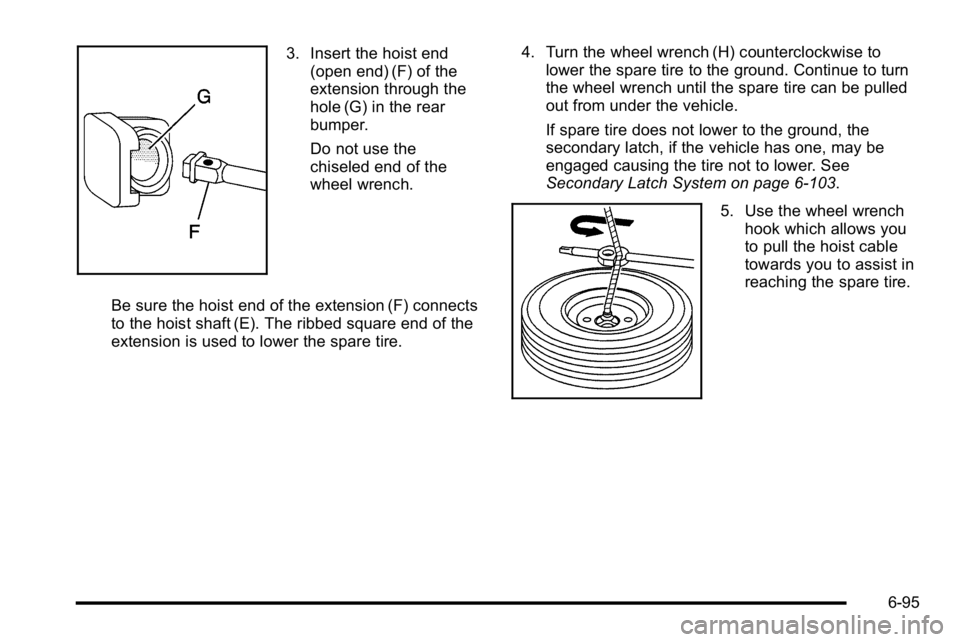
3. Insert the hoist end(open end) (F) of the
extension through the
hole (G) in the rear
bumper.
Do not use the
chiseled end of the
wheel wrench.
Be sure the hoist end of the extension (F) connects
to the hoist shaft (E). The ribbed square end of the
extension is used to lower the spare tire. 4. Turn the wheel wrench (H) counterclockwise to
lower the spare tire to the ground. Continue to turn
the wheel wrench until the spare tire can be pulled
out from under the vehicle.
If spare tire does not lower to the ground, the
secondary latch, if the vehicle has one, may be
engaged causing the tire not to lower. See
Secondary Latch System on page 6‑103.
5. Use the wheel wrench
hook which allows you
to pull the hoist cable
towards you to assist in
reaching the spare tire.
6-95
Page 542 of 630

6. Tilt the tire toward the vehicle with some slackin the cable to access the tire/wheel retainer.
Separate the retainer from the guide pin by
sliding the retainer up the pin while pressing
down on the latch.
Once the retainer is separated from the guide pin,
tilt the retainer and pull it through the center of the
wheel along with the cable and guide latch.
7. Put the spare tire near the flat tire.
6-96
Page 543 of 630
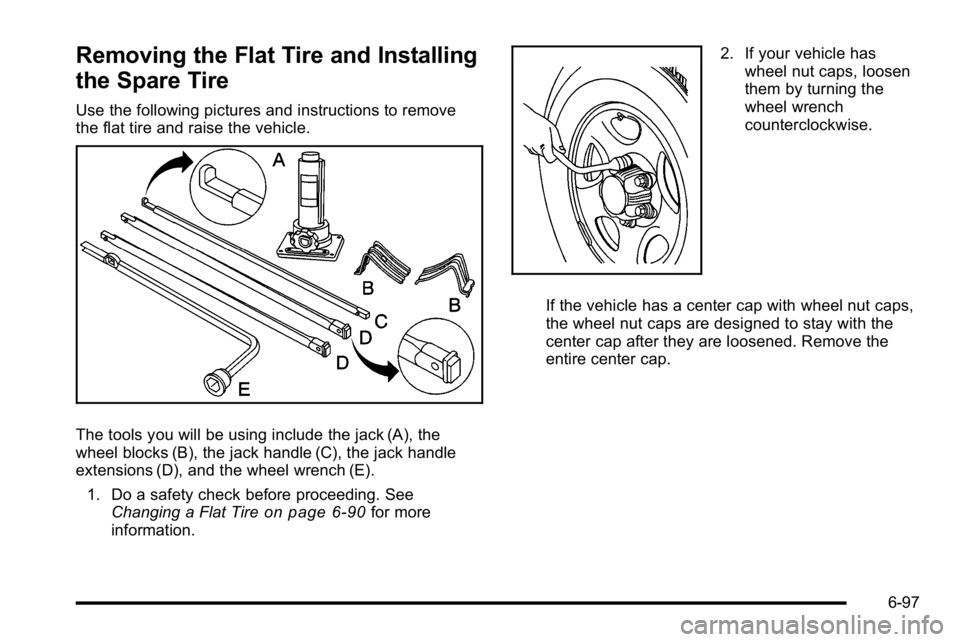
Removing the Flat Tire and Installing
the Spare Tire
Use the following pictures and instructions to remove
the flat tire and raise the vehicle.
The tools you will be using include the jack (A), the
wheel blocks (B), the jack handle (C), the jack handle
extensions (D), and the wheel wrench (E).1. Do a safety check before proceeding. See Changing a Flat Tire
on page 6‑90for more
information.
2. If your vehicle has wheel nut caps, loosen
them by turning the
wheel wrench
counterclockwise.
If the vehicle has a center cap with wheel nut caps,
the wheel nut caps are designed to stay with the
center cap after they are loosened. Remove the
entire center cap.
6-97
Page 544 of 630

If the wheel has a smooth center cap, place the
chisel end of the wheel wrench in the slot on the
wheel, and gently pry it out.3. Use the wheel wrench and turn it counterclockwiseto loosen the wheel nuts. Do not remove the wheel
nuts yet.
6-98
Page 545 of 630
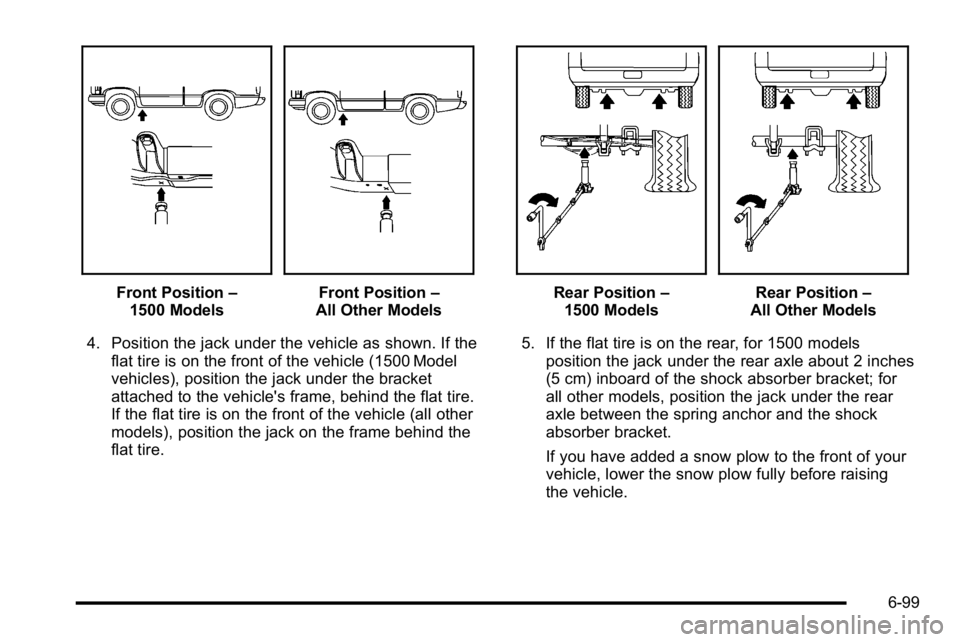
Front Position–
1500 ModelsFront Position –
All Other Models
4. Position the jack under the vehicle as shown. If the flat tire is on the front of the vehicle (1500 Model
vehicles), position the jack under the bracket
attached to the vehicle's frame, behind the flat tire.
If the flat tire is on the front of the vehicle (all other
models), position the jack on the frame behind the
flat tire.Rear Position –
1500 ModelsRear Position –
All Other Models
5. If the flat tire is on the rear, for 1500 models position the jack under the rear axle about 2 inches
(5 cm) inboard of the shock absorber bracket; for
all other models, position the jack under the rear
axle between the spring anchor and the shock
absorber bracket.
If you have added a snow plow to the front of your
vehicle, lower the snow plow fully before raising
the vehicle.
6-99
Page 546 of 630
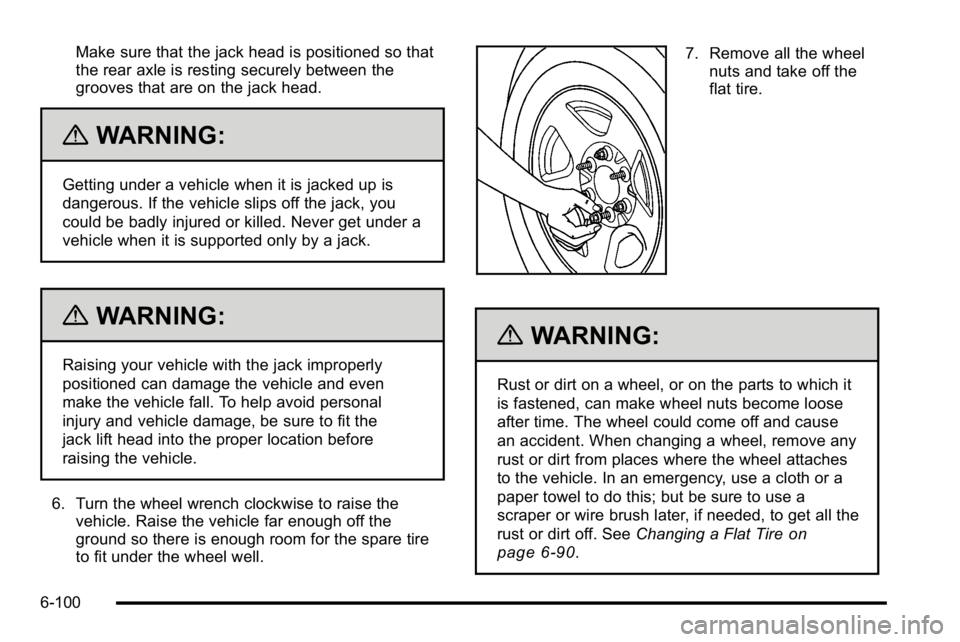
Make sure that the jack head is positioned so that
the rear axle is resting securely between the
grooves that are on the jack head.
{WARNING:
Getting under a vehicle when it is jacked up is
dangerous. If the vehicle slips off the jack, you
could be badly injured or killed. Never get under a
vehicle when it is supported only by a jack.
{WARNING:
Raising your vehicle with the jack improperly
positioned can damage the vehicle and even
make the vehicle fall. To help avoid personal
injury and vehicle damage, be sure to fit the
jack lift head into the proper location before
raising the vehicle.
6. Turn the wheel wrench clockwise to raise the vehicle. Raise the vehicle far enough off the
ground so there is enough room for the spare tire
to fit under the wheel well.
7. Remove all the wheelnuts and take off the
flat tire.
{WARNING:
Rust or dirt on a wheel, or on the parts to which it
is fastened, can make wheel nuts become loose
after time. The wheel could come off and cause
an accident. When changing a wheel, remove any
rust or dirt from places where the wheel attaches
to the vehicle. In an emergency, use a cloth or a
paper towel to do this; but be sure to use a
scraper or wire brush later, if needed, to get all the
rust or dirt off. See Changing a Flat Tire
on
page 6‑90
.
6-100
Page 547 of 630
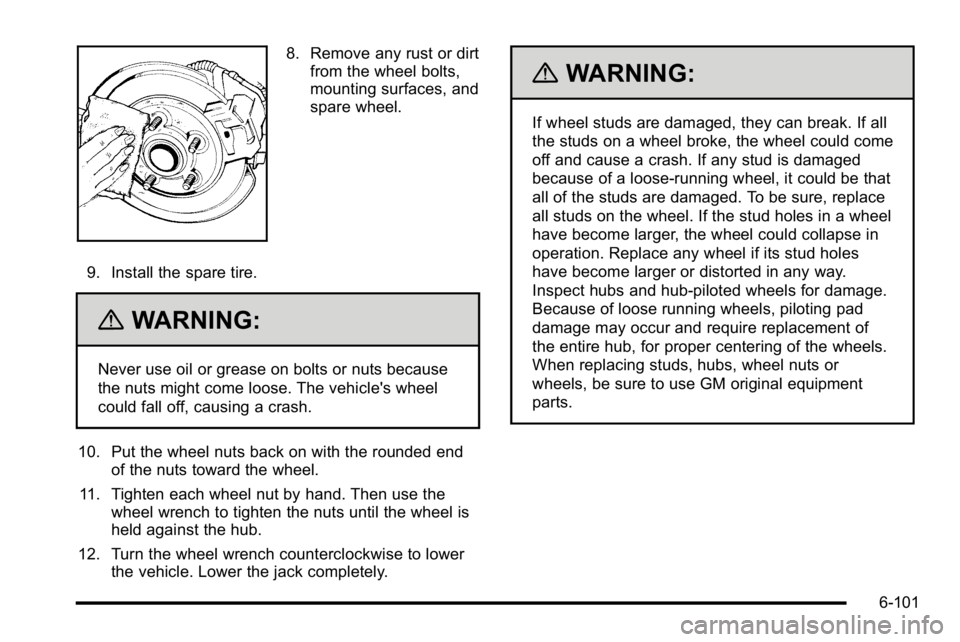
8. Remove any rust or dirtfrom the wheel bolts,
mounting surfaces, and
spare wheel.
9. Install the spare tire.
{WARNING:
Never use oil or grease on bolts or nuts because
the nuts might come loose. The vehicle's wheel
could fall off, causing a crash.
10. Put the wheel nuts back on with the rounded end of the nuts toward the wheel.
11. Tighten each wheel nut by hand. Then use the wheel wrench to tighten the nuts until the wheel is
held against the hub.
12. Turn the wheel wrench counterclockwise to lower the vehicle. Lower the jack completely.
{WARNING:
If wheel studs are damaged, they can break. If all
the studs on a wheel broke, the wheel could come
off and cause a crash. If any stud is damaged
because of a loose-running wheel, it could be that
all of the studs are damaged. To be sure, replace
all studs on the wheel. If the stud holes in a wheel
have become larger, the wheel could collapse in
operation. Replace any wheel if its stud holes
have become larger or distorted in any way.
Inspect hubs and hub‐piloted wheels for damage.
Because of loose running wheels, piloting pad
damage may occur and require replacement of
the entire hub, for proper centering of the wheels.
When replacing studs, hubs, wheel nuts or
wheels, be sure to use GM original equipment
parts.
6-101
Page 548 of 630
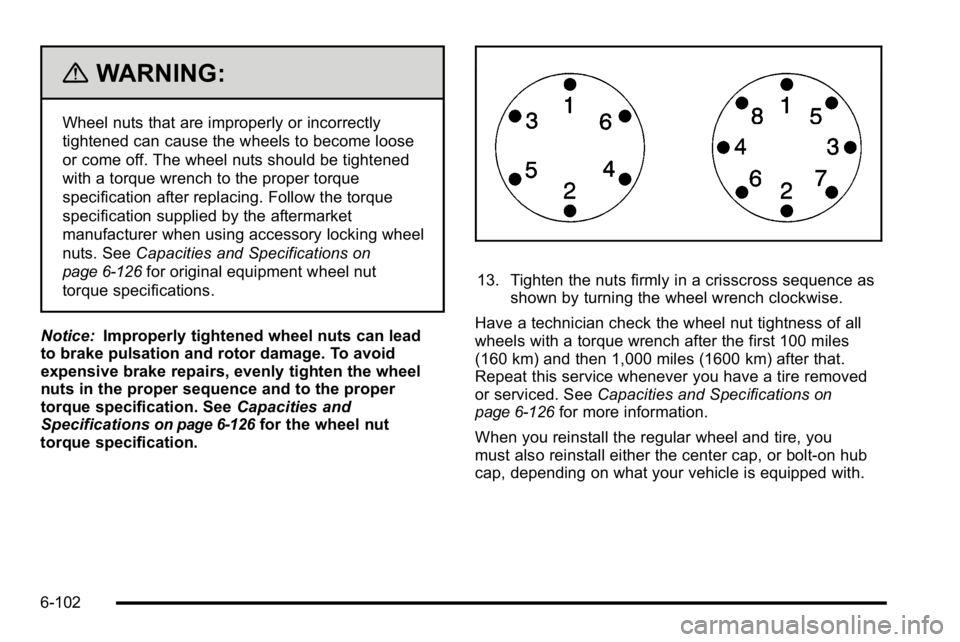
{WARNING:
Wheel nuts that are improperly or incorrectly
tightened can cause the wheels to become loose
or come off. The wheel nuts should be tightened
with a torque wrench to the proper torque
specification after replacing. Follow the torque
specification supplied by the aftermarket
manufacturer when using accessory locking wheel
nuts. SeeCapacities and Specifications
on
page 6‑126
for original equipment wheel nut
torque specifications.
Notice: Improperly tightened wheel nuts can lead
to brake pulsation and rotor damage. To avoid
expensive brake repairs, evenly tighten the wheel
nuts in the proper sequence and to the proper
torque specification. See Capacities and
Specifications
on page 6‑126for the wheel nut
torque specification.
13. Tighten the nuts firmly in a crisscross sequence as
shown by turning the wheel wrench clockwise.
Have a technician check the wheel nut tightness of all
wheels with a torque wrench after the first 100 miles
(160 km) and then 1,000 miles (1600 km) after that.
Repeat this service whenever you have a tire removed
or serviced. See Capacities and Specifications
on
page 6‑126for more information.
When you reinstall the regular wheel and tire, you
must also reinstall either the center cap, or bolt-on hub
cap, depending on what your vehicle is equipped with.
6-102
Page 549 of 630
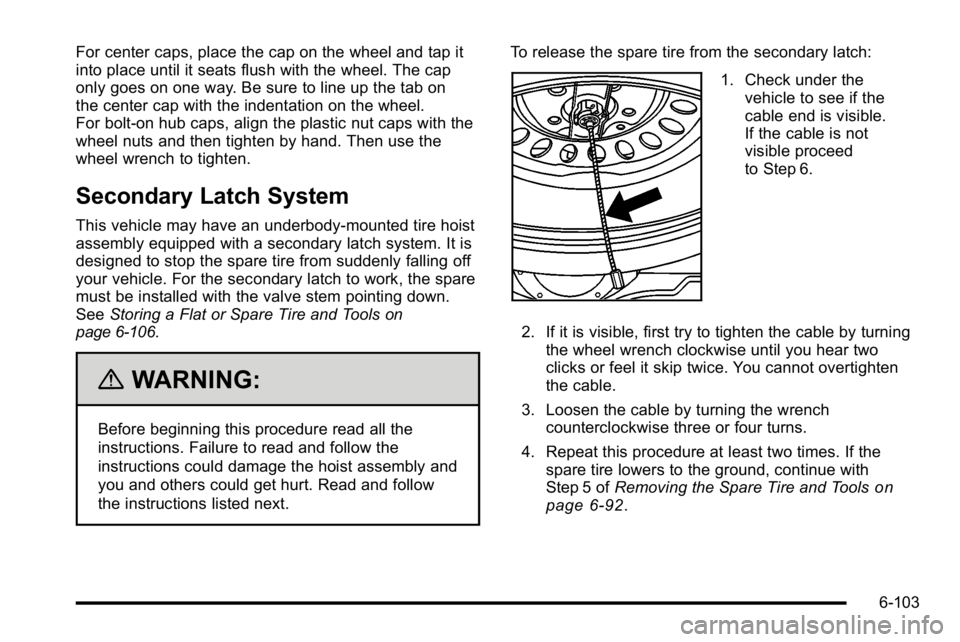
For center caps, place the cap on the wheel and tap it
into place until it seats flush with the wheel. The cap
only goes on one way. Be sure to line up the tab on
the center cap with the indentation on the wheel.
For bolt-on hub caps, align the plastic nut caps with the
wheel nuts and then tighten by hand. Then use the
wheel wrench to tighten.
Secondary Latch System
This vehicle may have an underbody-mounted tire hoist
assembly equipped with a secondary latch system. It is
designed to stop the spare tire from suddenly falling off
your vehicle. For the secondary latch to work, the spare
must be installed with the valve stem pointing down.
SeeStoring a Flat or Spare Tire and Tools
on
page 6‑106.
{WARNING:
Before beginning this procedure read all the
instructions. Failure to read and follow the
instructions could damage the hoist assembly and
you and others could get hurt. Read and follow
the instructions listed next. To release the spare tire from the secondary latch:
1. Check under the
vehicle to see if the
cable end is visible.
If the cable is not
visible proceed
to Step 6.
2. If it is visible, first try to tighten the cable by turning the wheel wrench clockwise until you hear two
clicks or feel it skip twice. You cannot overtighten
the cable.
3. Loosen the cable by turning the wrench counterclockwise three or four turns.
4. Repeat this procedure at least two times. If the spare tire lowers to the ground, continue with
Step 5 of Removing the Spare Tire and Tools
on
page 6‑92.
6-103
Page 550 of 630

5. If the spare does not lower, turn the wrenchcounterclockwise until approximately 6 inches
(15 cm) of cable is exposed.
6. Stand the wheel blocks on their shortest ends, with the backs facing each other.
7. Place the bottom edgeof the jack (A) on the
wheel blocks (B),
separating them so that
the jack is balanced
securely.
8. Attach the jack handle, extension, and wheelwrench to the jack and place it (with the wheel
blocks) under the vehicle toward the front of the
rear bumper.
6-104